Time Travel: Vintage Ads That Are Too Outrageous for Today’s Sensibilities!
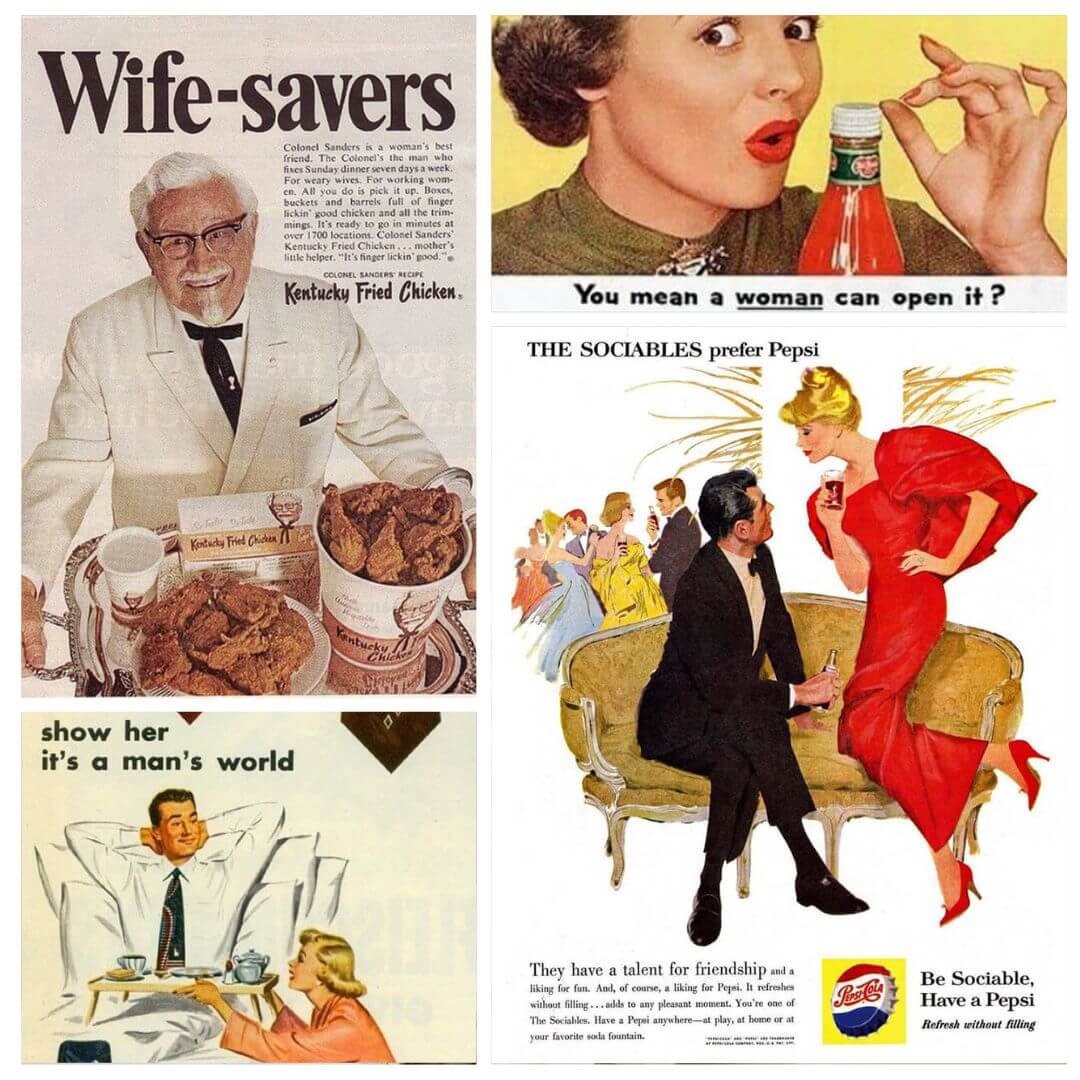
Whirring back to an era where advertising was a wild west of creativity and audacity, it’s easy to imagine that it’s more than just selling a product; it’s about crafting messages that resonate with specific audiences, turning them into loyal customers. But here’s the twist: the advertising landscape wasn’t always draped in the politically correct norms we uphold today.
What was once considered playful and daring might now raise everyone’s eyebrows in disbelief. This journey isn’t just a walk down memory lane—it’s a revelation of how far we’ve come in our collective thinking. Prepare to see some of the most astonishing, sometimes outrageous moments in immortalized advertisements that would unquestionably be off-limits and perhaps be criticized in today’s more enlightened society.
Vitamin B for Beauty
The ad charmingly shows a wife aglow amid her chores while her husband, weary from work, marvels at her energy. “The harder a wife works, the cuter she looks!” it proclaims. The punchline? Vitamins are her secret!
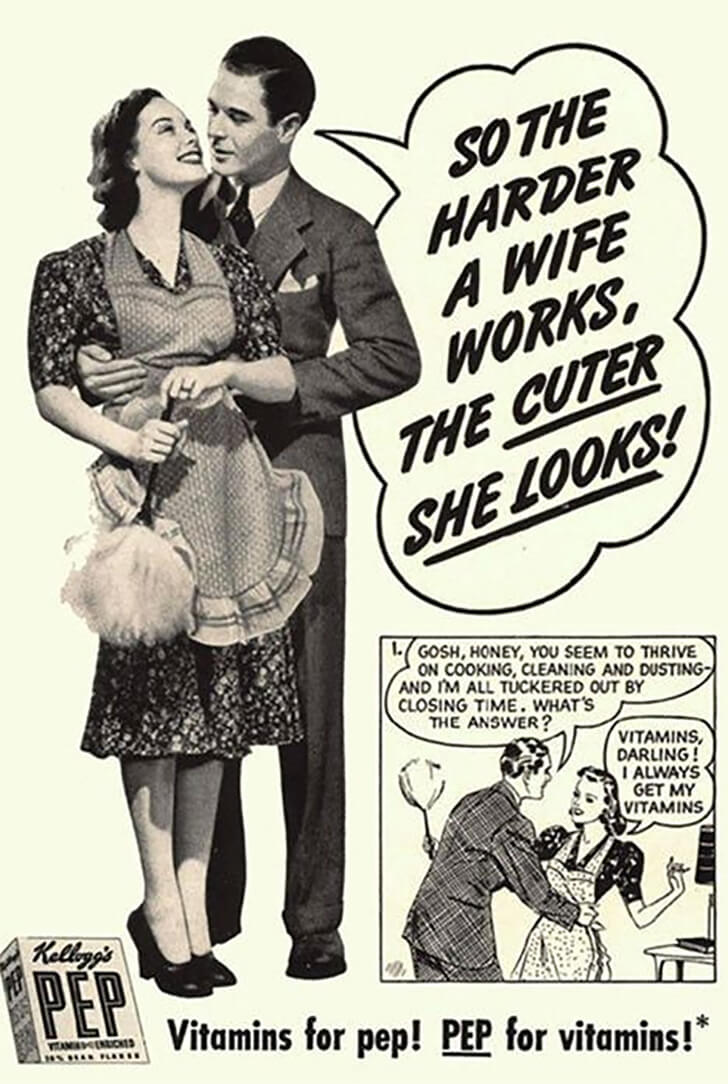
This ad captures a vintage sentiment, amusing in its quaint and outdated view of spousal roles. Kellogg’s, once famous for fortifying meals with extra vim, is now synonymous with breakfast cereals that pack a nutritious punch, keeping the legacy of wellness, albeit with a modern twist.
When Gaming Consoles Dominated The 1980s
In the high-octane era of the 1980s, SEGA unleashed an ad that would be a no-go with today’s standards. Its bold claim celebrated the gripping, intense challenge of mastering their games. The ad’s innuendo-laced language played with the era’s boundary-pushing humor, hyping the adrenaline-pumping experience of the 16-bit Mega Drive and its joystick.
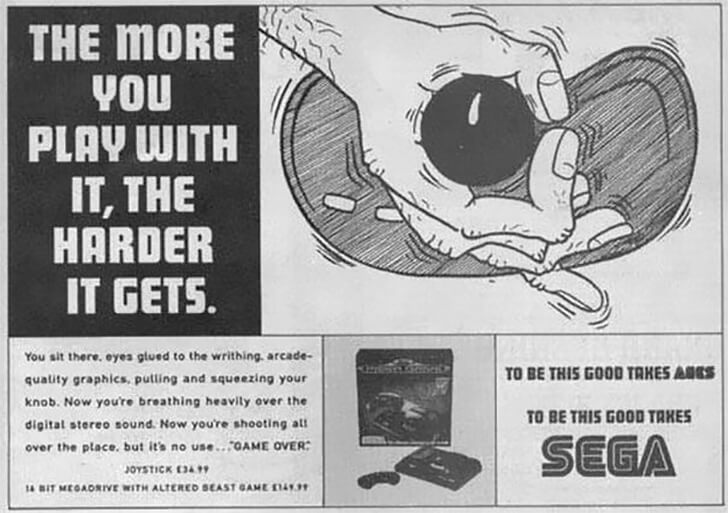
It’s funny because it cheekily conflated the gaming struggle with suggestive wordplay. The Mega Drive became a legend, defining a generation with its advanced graphics and sound, a far cry from the simplistic blips and bloops of earlier games.
Keeping Women In Their Places
Weyenberg Massagic Shoes’ ad for their Hush Puppies style shoe is a vintage piece that would never make the cut today. The bold declaration “keep her where she belongs” reflects an outdated humor that won’t fare well today.
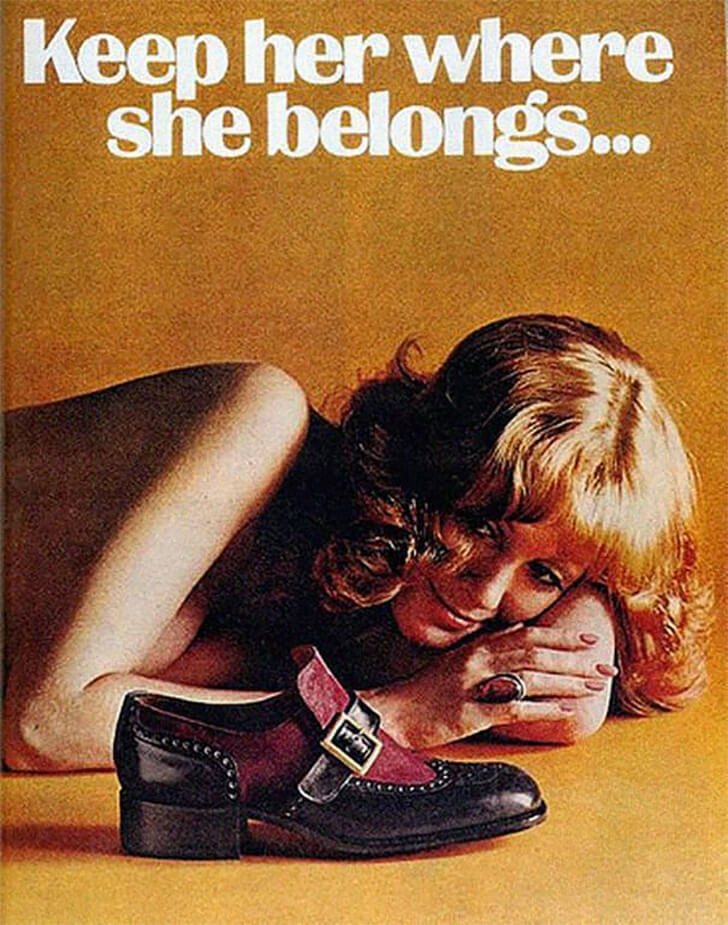
Hush Puppies, founded in 1958, revolutionized the shoe industry by offering a reprieve from the stiff, dressy footwear of the time. Their mission? To silence weary “barking dogs” with unprecedented comfort. Pioneers of the casual shoe movement, they introduced Bounce Technology, continuing to innovate and ensuring that comfort steps with you, not just where you ‘belong.’
Women Are What Now?
This vintage campaign delivers a backhanded compliment, “Beautiful but dumb.” The irony here is thick, presenting beauty as insufficient without the smarts to stay fresh. It’s a chuckle-worthy reminder of how blunt past advertising could be.
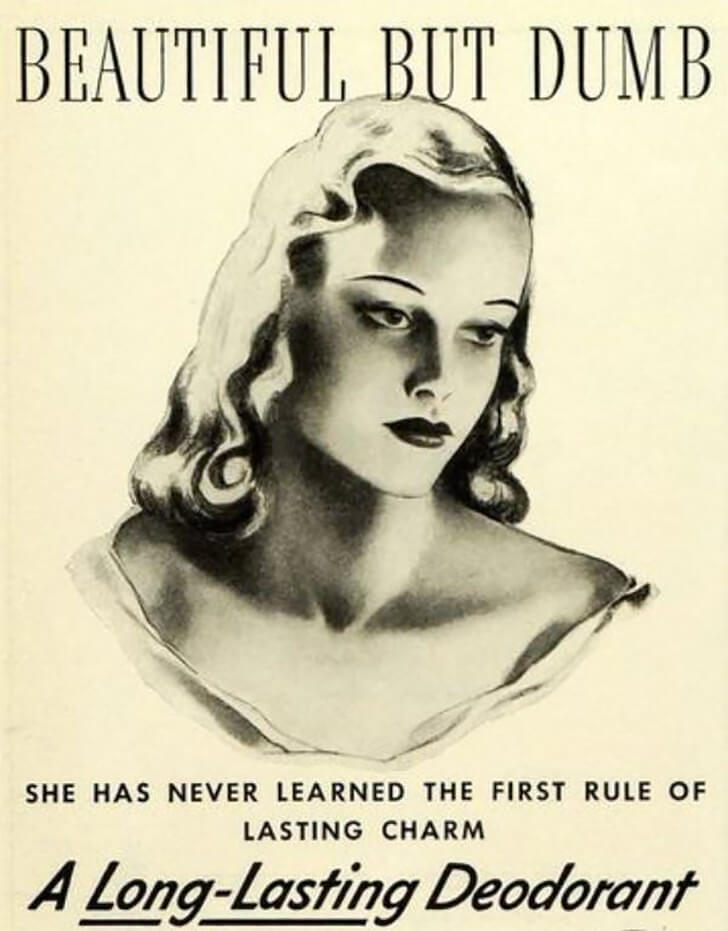
Today, such an approach would likely be shelved for its insensitivity. For a bit of deodorant trivia: The first commercial deodorant from Mum was patented in 1888, and since then, the science of sweat has come a long way, thankfully with more tactful marketing.
Rocket in Your Pocket
This ad shows a woman astride a pen-rocket, soaring into hyperbole with the claim, “Writes 15 years without refilling.” The tagline, “Got a rocket in your pocket?” adds a playful double entendre.
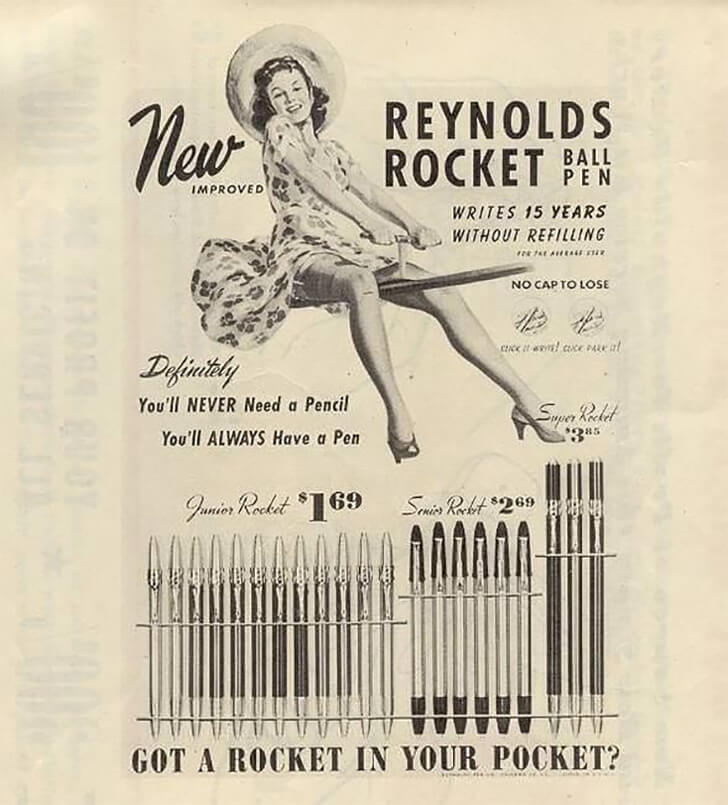
This pen is not a scribbler but a durable marvel designed to outlast others. Milton Reynolds, seizing the commercial potential of the ballpoint after encountering a Birome pen in Argentina, forged a legacy back in the day. With their ribbed bodies and clever cap-less tops, his pens promised a new age of writing convenience.
What Made a Man Attractive? Socks!
Here’s one that would make modern marketers blush: an ad featuring a dashing lady, an embodiment of grace, with a man’s sock-clad feet casually resting in her lap. The caption is a clever play on words—transforming what is commonly known into a sock-centric quip—that seamlessly stitches together humor and product promotion.

Speaking of socks, as per history, the Smithsonian reports that the oldest known pair dates back to 300-500 AD, was discovered in Egypt, and was designed for sandal wear. Now, it is mostly used with shoes!
This Is Not How Babies Come Into This World
This DuPont Cellophane ad captures attention with a bird tenderly clutching a cellophane that cradles a smiling baby. While aiming for cuteness, it unwittingly skates on thin ice with modern safety standards.
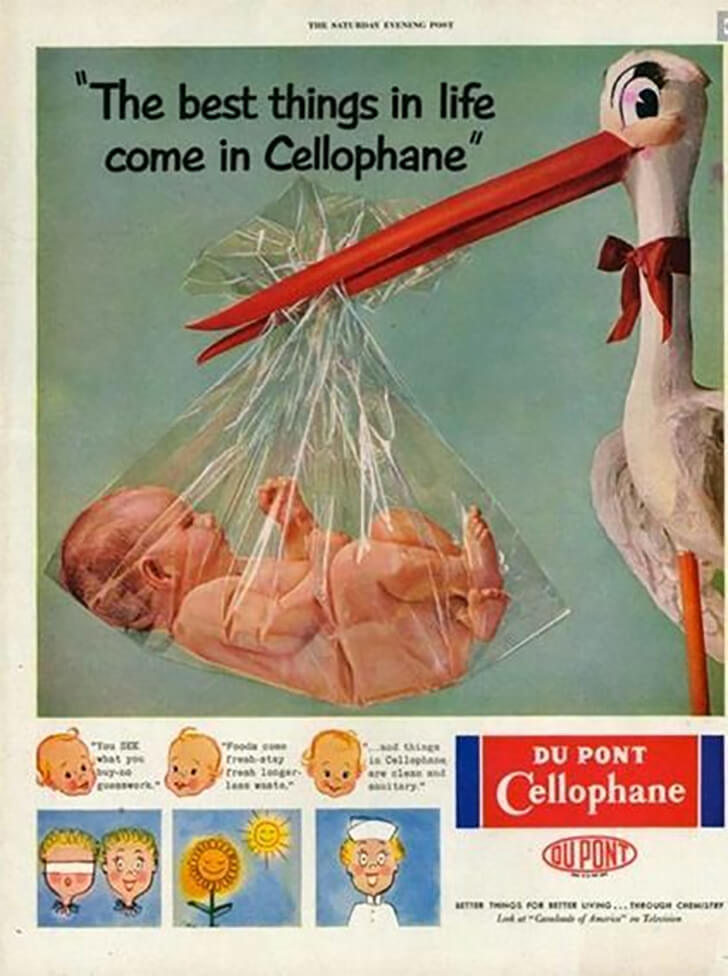
The visual of a baby encased in plastic is paradoxically charming yet alarming, a stark contrast to current awareness of suffocation hazards associated with plastic. It’s an unwitting nod to an era less informed about the dangers of plastic. While it tries to embody purity and protection, it inadvertently highlights the importance of vigilance in product safety messaging.
Not Really The Best Way to Convince Kids These Days
This particular ad, which wouldn’t make the cut today, portrays a young soldier in mid-throw, grenade in hand, lamenting with the line, “OH LORD, WHY DO I THROW LIKE A GIRL?” It then urges parents to let their sons play Little League.
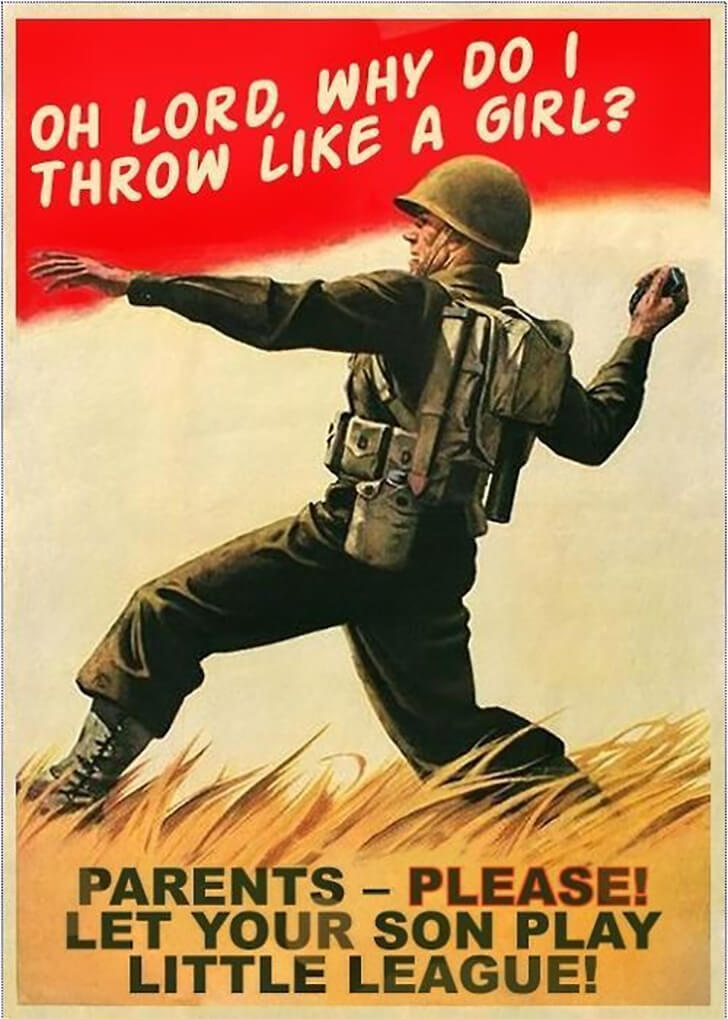
The humor emerges from the dramatic overplay of ‘manly’ stereotypes, which are, thankfully, outdated. Interestingly, language like this is a stark example of how words can perpetuate stereotypes, reflecting societal views that have since been widely discredited and dismissed.
How About If Women Hated The Sight of You?
This old ad for Ironized Yeast humorously dramatizes the plight of the “skinny dame,” shunned until she gains weight thanks to this product. It laments a woman before the yeast works its magic. Weeks later, she’s the belle of the ball, having gained the pounds.

The ad’s charm lies in its over-the-top promise, a nod to vintage marketing’s flair for the dramatic. On the science side, yeast, a cornerstone in baking, ferments sugars, releasing carbon dioxide that makes bread rise. But as a weight gain miracle? That’s purely old-school advertising magic.
What’s The Product?
What’s impressive about this ad is the three-in-one appliance. It boasts a stacked ensemble of a microwave, hot food server, and self-cleaning oven. The tagline “stacked for convenience” might elicit a chuckle today, as it ambiguously plays on the word ‘stacked,’ leaving one to wonder, what is stacked in this marketing piece?
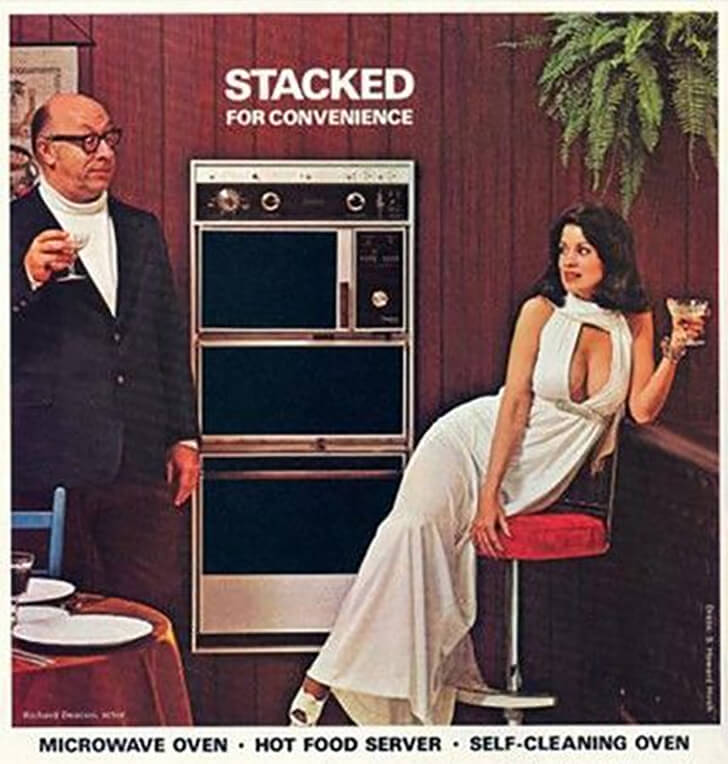
Self-cleaning ovens, a nifty innovation, use high temperatures to incinerate food residues, simplifying the arduous task of oven scrubbing. Yet, this ad is a guessing game as to which gleaming gadget is the star.
How Not to Be Awkward? Drink Pepsi
Pepsi’s advertising took a playful turn that would undoubtedly raise eyebrows today. This shows a woman in a gorgeous red dress holding a glass of this drink while a man gazes at her with an intensity that screams “social charm.” The caption reads, “The Sociables prefer Pepsi.”

Sipping this was the secret to being a social butterfly. It promised a talent for friendship, a penchant for fun, and, of course, a thirst for Pepsi, which was once called Brad’s Drink itself. The idea that a soft drink could transform you into a social superstar is downright comical.
Even Kids Couldn’t Run Away from Bad Ads
This Chiquita Bananas ad would likely not pass today’s standards. It features two children, with a boy offering a banana to a girl in an innocent gesture that may be misconstrued through a modern lens.
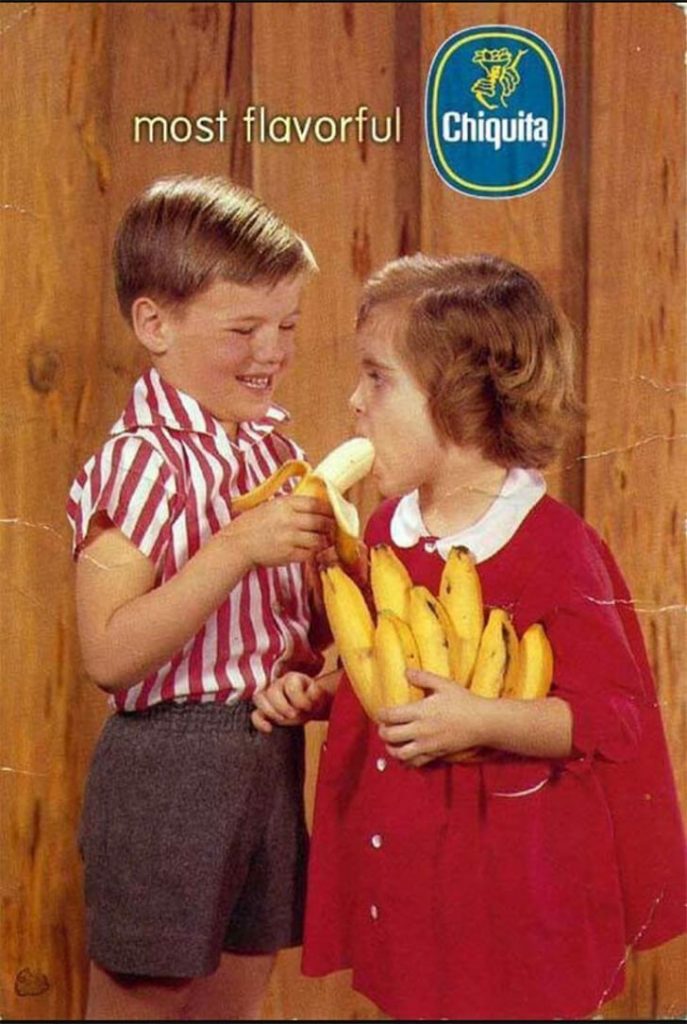
The ad’s unintended implications make it humorously outdated, reflecting the shift in societal norms regarding the portrayal of minors in media. A bite-sized tidbit: Chiquita introduced the first refrigerated ships in 1947, revolutionizing the transport of fresh produce globally. While benign in intent, this ad’s misplaced portrayal highlights the evolution of advertising sensibilities.
Coffee With Controversy
This Chase & Sanborn Coffee ad depicts a man poised as if to discipline his wife over her coffee faux pas, with a stern warning to women everywhere about the perils of not ‘store-testing’ for freshness. It’s an eyebrow-raising snapshot of past advertising tactics, where the stakes for choosing the right coffee were humorously overstated.
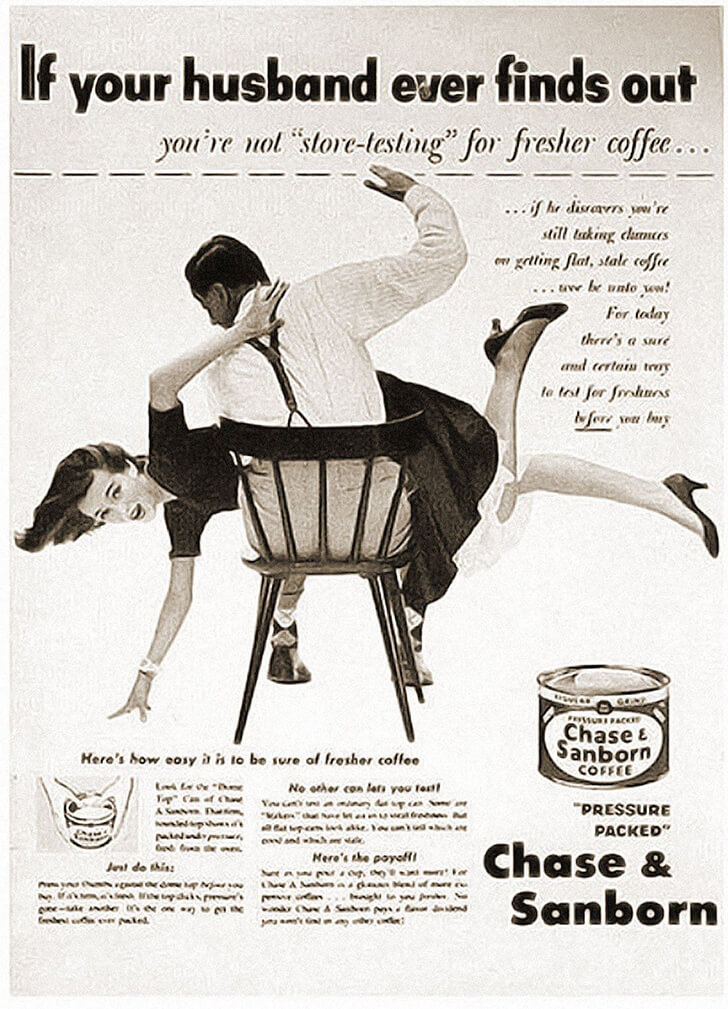
What makes this ad intriguing is its vintage approach to consumer education, with a wink. Beyond the ad’s anachronistic drama, coffee’s complexity lies in its freshness; the flavor profile of coffee beans diminishes with time due to the volatile compounds deteriorating.
The Losers Then, Winners Now?
This vintage Eastern Airlines ad takes us back to an era when hiring standards for stewardesses were as sky-high as the planes they worked on. “Presenting The Losers,” it boldly begins, showcasing women who didn’t make the cut—not for lack of charm but because Eastern’s criteria soared beyond just appearance.
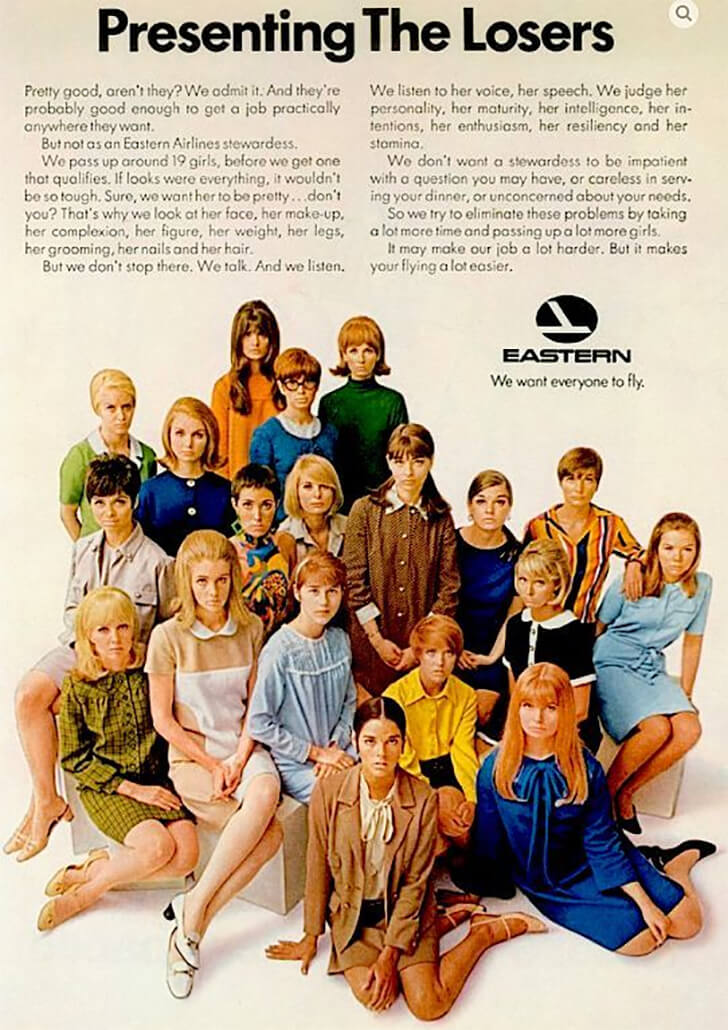
The ad humorously details an exhaustive checklist from poise to personality, all to ensure passengers’ comfort. It’s a humorous peek into the past’s stringent airline standards. The first flight attendants were registered nurses, which added a touch of care to the skies!
Who Needs a Man to Open a Bottle?
This ketchup ad plays on outdated stereotypes with a wink, showing a woman nearly popping open a bottle accompanied by the incredulous, “You mean a woman can open it?” It’s a humorous jab at the outdated notion that jar-opening is a man’s task, rooted in the era’s social norms that often relegated women to less physically demanding roles.
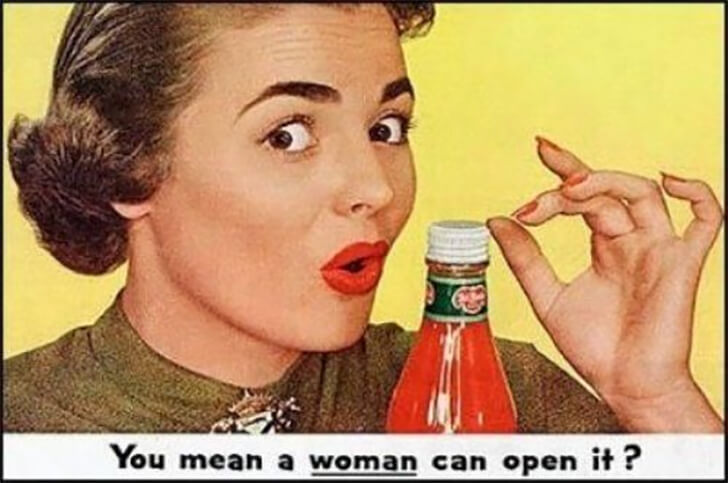
The ad’s humor is its gentle irony, spotlighting a shift in perceptions. Interestingly, the idea that men are the default bottle-openers may stem from historical divisions of labor, where men’s work was associated with strength.
Mother on Board? Only with American Airlines
An American Airlines ad had an intriguing pitch. It amusingly suggests that the airline’s service is akin to maternal care, complete with a cool drink and a soft pillow, attributing this to extensive stewardess training rather than mere looks.

This ad whimsically blurs lines between comfort at home and in the skies, promising a nurturing experience. The humor arises from comparing the stewardess to a mother, assuring passengers of a familial level of attention. Yet, it winks at the notion of a much younger, glamorous ‘mother’ aboard.
Coca-Cola’s Subtle Hints
This vintage Coca-Cola ad tickles the funny bone with its playful double entendre. Featuring a slim woman holding two six-packs, the slogan teases, “For extra fun… take more than one!” Winking at a time when ads nudged nudge-wink-wink humor, this one plays with the idea of doubling the pleasure, suggesting perhaps a companion rather than just an extra soda.

And for a fizzy fact: Coca-Cola originally contained coca leaves until 1929—talk about an ‘extra’ ingredient! Never mind this ad; the beverage remains much beloved today!
Neck Tie = Man’s World?
This vintage ad now seems as retro as the tie styles it promoted. We see a man lounging on a bed, the epitome of relaxation, while a woman kneels beside him, offering a tray of food. With the bold declaration, “Show her it’s a man’s world,” the ad reflects a bygone era’s norms.

On a lighter note, did you know the modern necktie traces back to Croatian mercenaries of the 17th century? Their knotted neckerchiefs caught the eye of Parisians, tying the knot on a fashion trend that endures to this day.
Hide Your Wives, Colonel Sanders Is Here
It showcased Colonel Sanders as the gallant savior of domestic tranquility, presenting his crispy chicken as a panacea for the overworked homemaker. This vintage portrayal, amusingly dated now, hinged on the stereotype of women needing rescue in the kitchen.
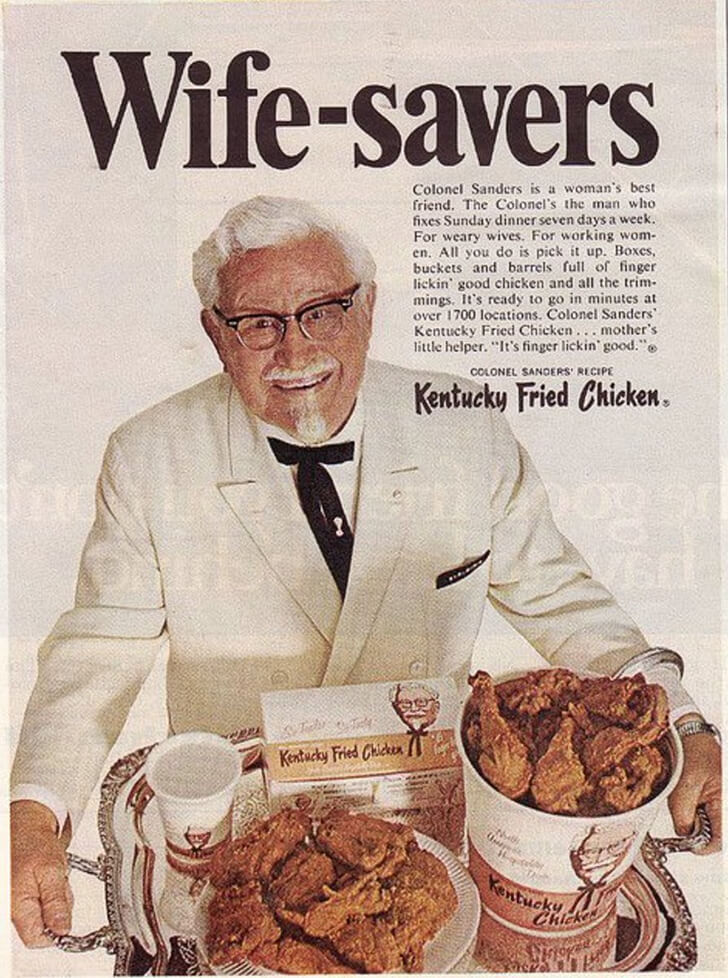
Today, it serves up a chuckle for its old-fashioned take on gender roles. On a tastier note, did you know KFC’s secret blend of 11 herbs and spices remains one of the culinary world’s most enduring mysteries, tightly locked away in a vault?
Swimsuits to Attract a Crush?
In a bygone era of advertising, Jantzen swimsuits pushed the boundaries with a jaw-dropping ad. This shows a woman flaunting her allure in a sizzling swimsuit, while by her side, a gentleman donning an equally risqué swimming attire.

The text, teasingly daring, reads, “Lure him… away from the pool boy.” The humor lies in the audacious implication, defying today’s sensibilities. But here’s a fun twist: Jantzen is credited with introducing the term “swimming suit” instead of the previous “bathing costume.”
Harness for Dogs or Babies?
The past’s peculiar parenting practices somehow surface in this vintage advertisement, which seems to show a toddler in a car seat, tethered by a leash—a sight that would have modern parents aghast.
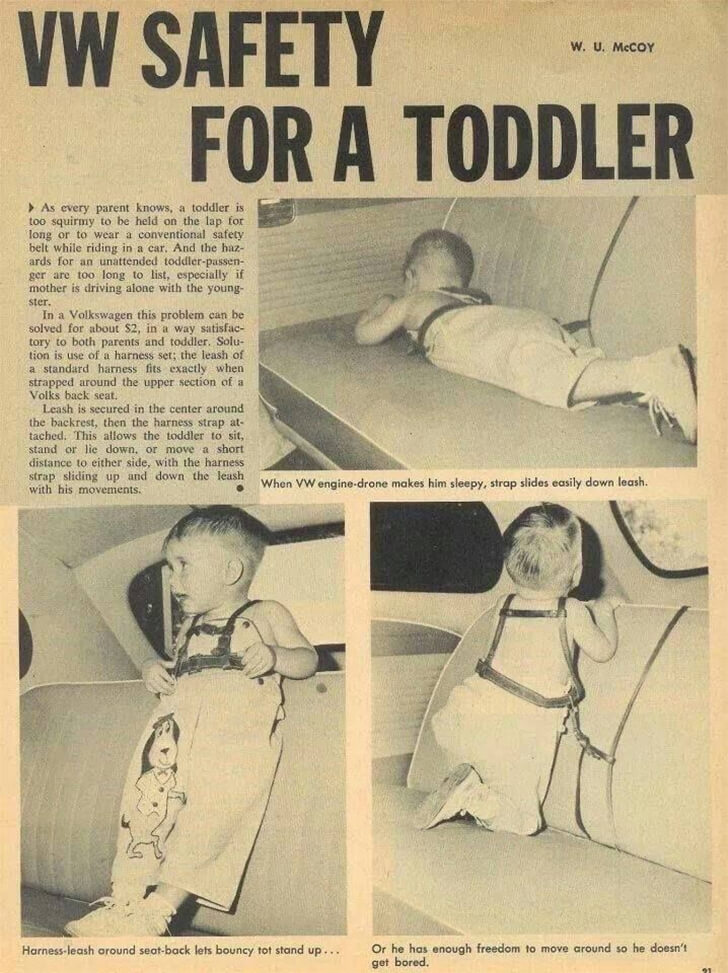
What tickles the funny bone is not just the absurdity of the image by today’s standards but also the nonchalance with which it presents the “safety” measure. Today, we know that proper seatbelts and car seats are non-negotiable for children’s safety. Interestingly, it wasn’t until 1985 that all 50 U.S. states had laws requiring young children to be secured in safety seats, a far cry from the laissez-faire leashes of yesteryear!
It’s Daring, Audacious, Bolder Look—And Eyebrow-Raising!
In a quirky Van Heusen advertisement from yesteryear, which would surely raise eyebrows today, the shirtmaker’s approach to marketing was as colorful as their attire. With scenes of a playful spank, a romantic kiss, and a cozy hug, the ad exclaims, “It’s daring, it’s audacious, it’s the bolder look in shirts.”
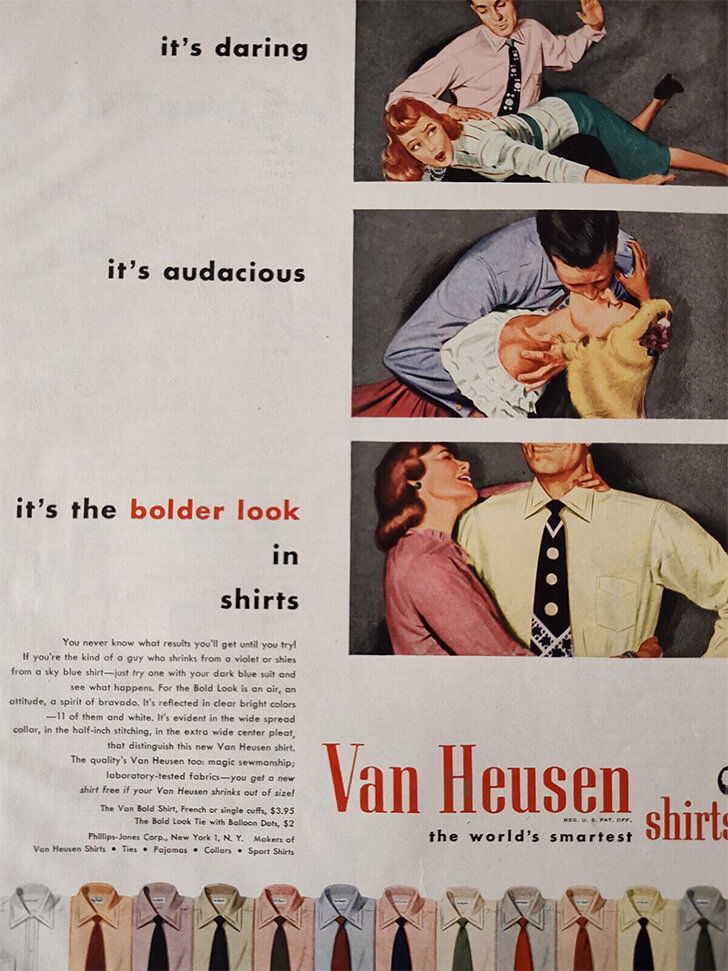
Van Heusen has buttoned up its act since, known now for innovating the soft folding collar, making stiff collars a thing of the past. These days, it still remains popular for their collared shirts.
It Was Never OK to Put a Baby Under a Sun Lamp!
This DuPont advertisement promoted a “Health Tan” sun lamp, where a serene mother gently holds her baby under the glow of artificial sunshine. The ad confidently claims, “Can’t Burn! Patented. Sleep under it.” It’s humorously naïve, reflecting a time when the line between science and salesmanship was as blurred as a suntan in winter.

The irony? Today, we know that prolonged exposure to UV rays, artificial or not, can be harmful—a fact DuPont’s sun lamp blissfully ignores. It’s a classic case of ‘don’t try this at home,’ preserved in the annals of advertising missteps.
The Best Way to Wake Up in the Morning
This Ovaltine ad features a woman, radiant and vivacious, having just silenced her alarm—clearly a success story. The catchphrase “Wake up perky in the morning!” encapsulates the promise of vitality from a simple beverage.

The ad’s comedic value lies in its earnest assurance that a malt drink can transform mornings from dreary to delightful. And for a dash of trivia: Ovaltine was originally called “Ovomaltine,” a mix-up in registration led to the name we recognize today—a happy accident for a brand synonymous with starting the day with a spark!
Not Really The Best Personalities To Promote
One might get tickled by a Camel Cigarettes promotion that would never make it to print today. It boasts, “More doctors smoke Camels than any other cigarette,” touting a survey of over 100,000 doctors.
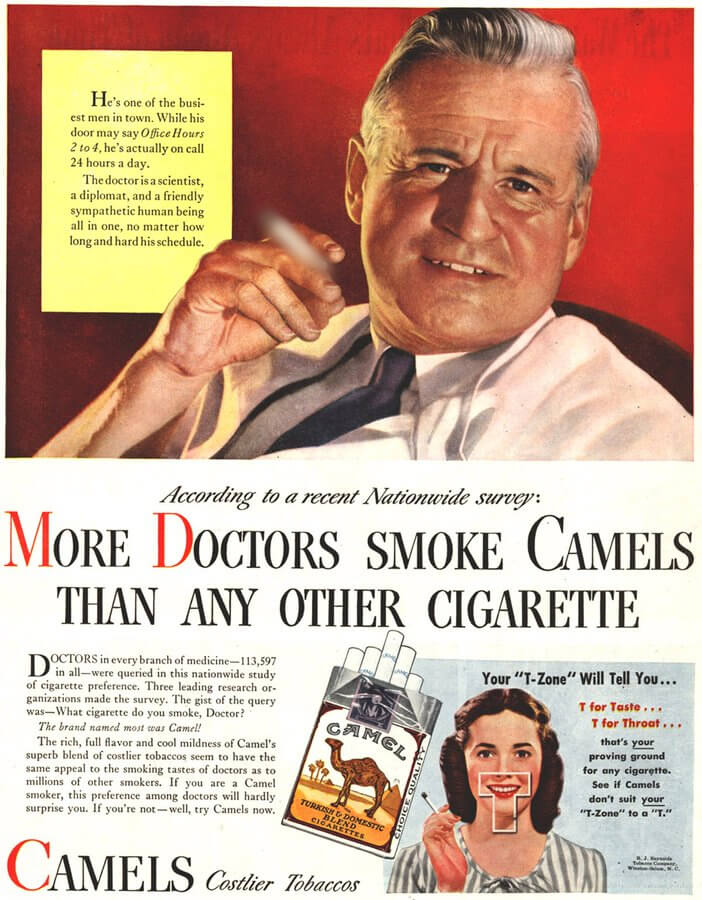
It’s humorously ironic now, given our knowledge of this vice’s health effects, that physicians were once used to endorse tobacco. The ad highlights the “rich, full flavor and cool mildness” of Camel’s blend, aiming to entice smokers with the same preferences that supposedly captivated experts.
Is This The Right Way to Be Energized?
In a peculiar advertising twist, a vintage 7-Up ad presents a whimsical take on recharging one’s energy. The image, now viewed as quite antiquated, depicts a man preparing to bowl, with a playful scenario hinting at a spank.
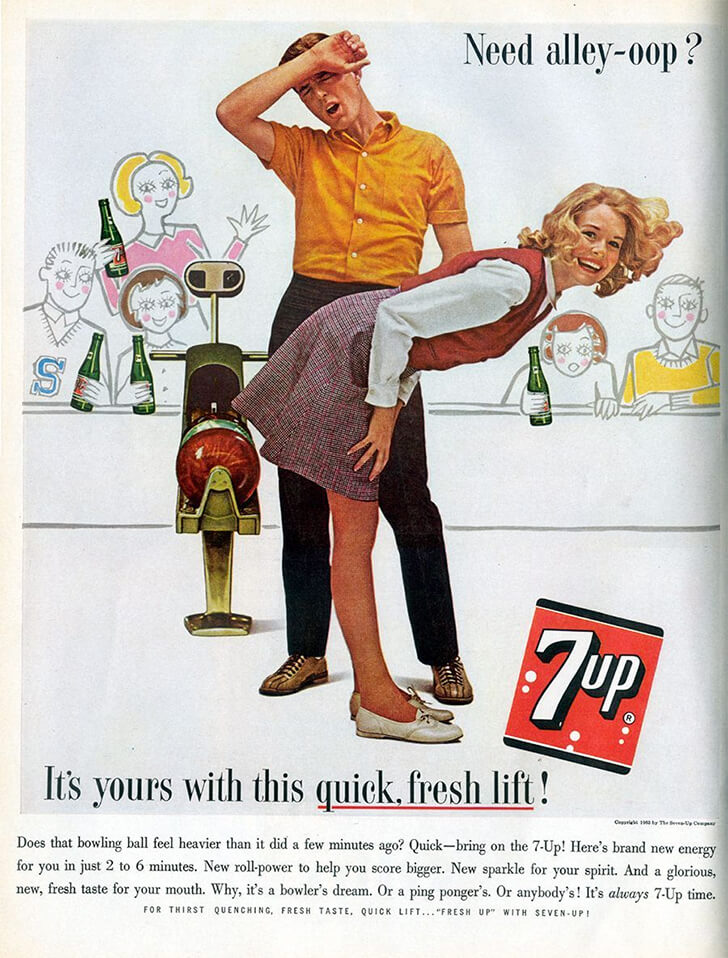
The humor springs from the unexpected metaphor relating a soft drink to bowling prowess and high spirits. It’s an amusing glimpse into past promotional tactics, where soda was the solution to all our leisurely woes. A sip of history: Did you know 7-Up was originally named “Bib-Label Lithiated Lemon-Lime Soda”? Quite the mouthful before it struck branding gold!
Secondhand Smoke is No Laughing Matter
This Tipalet ad may be something anyone can smell from the screen. A suave gentleman is seen blowing smoke directly into a lady’s face. With the tagline “Blow in her face and she’ll follow you anywhere,” it’s an eyebrow-raising scene that’s more likely to induce a cough than a follow.
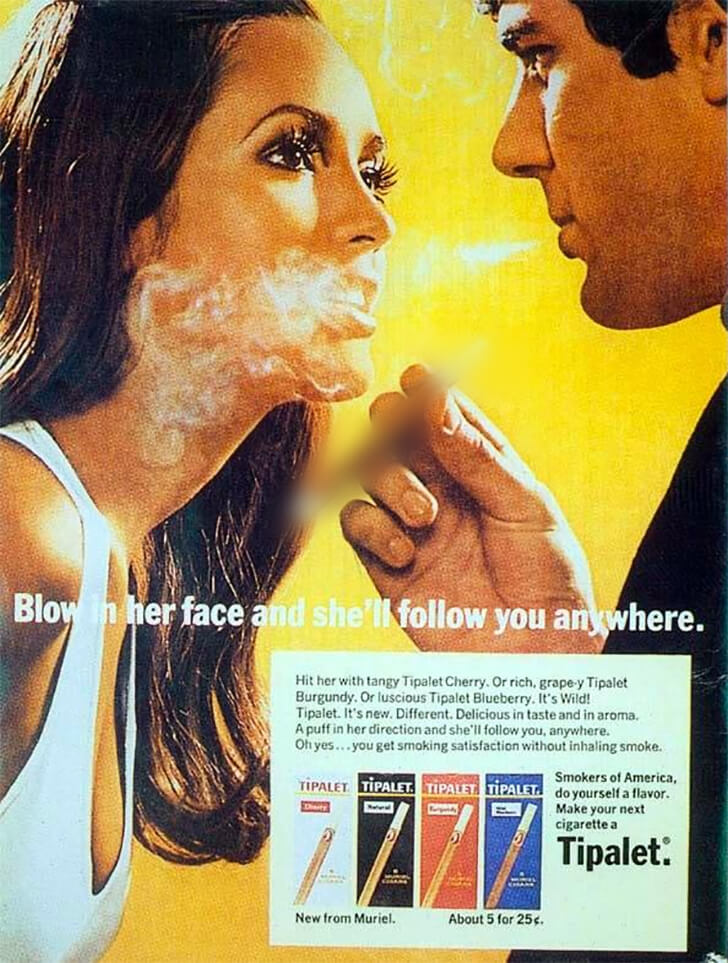
The ad’s hook was meant to be playful, suggesting that flavored cigarette smoke could be as charming as a fragrant cologne. It’s a humorous, albeit misguided, snapshot of past marketing that didn’t quite grasp the gravity of secondhand smoke—a health hazard we’re well aware of today.
Parents Should Take Caution About Believing in Ads
Back then, one might stumble upon an eyebrow-raising spectacle: a baby wielding a razor, pretending to shave. This comical and somewhat unnerving image hails from an era when safety standards were more suggestion than statute.
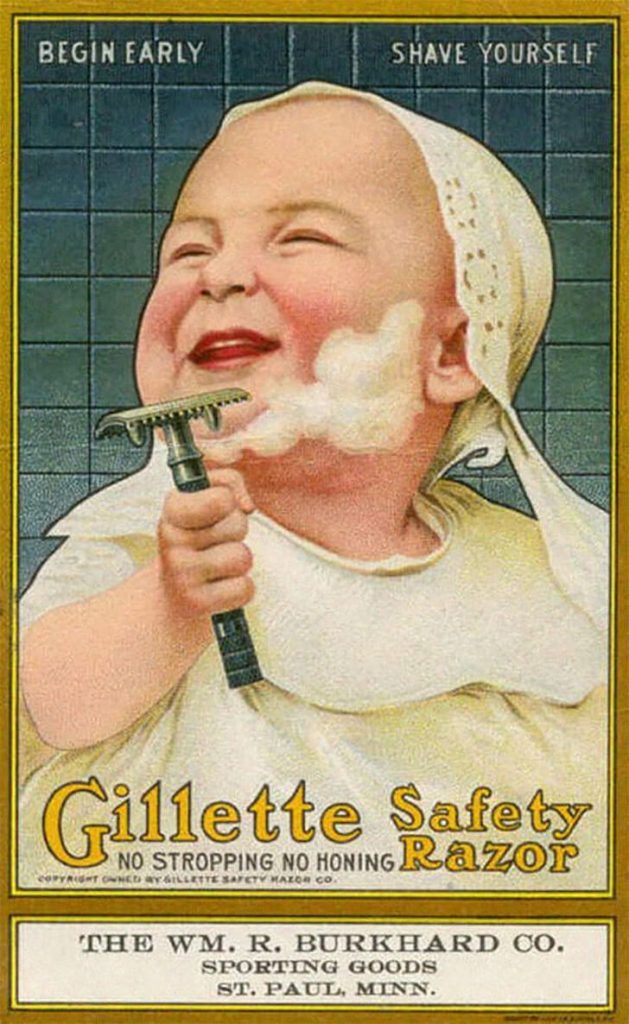
The humor lies in the absurdity—babies mirroring grown-up routines, yet it’s a stark reminder of how far we’ve come in recognizing the importance of child safety. It’s a chuckle-worthy nod to times past, if not a bit jarring. Interestingly, King Camp Gillette patented the first safety razor in 1904, revolutionizing how we shave by introducing replaceable blades.
How Not To Stereotype a Blonde
The ad plays on the surprise that such a compact device could offer powerful computing, humorously addressing the user as a “sweet telex operator.” The fun continues with a tongue-in-cheek nod to the device’s sophisticated features, touted to impress any tech enthusiast.
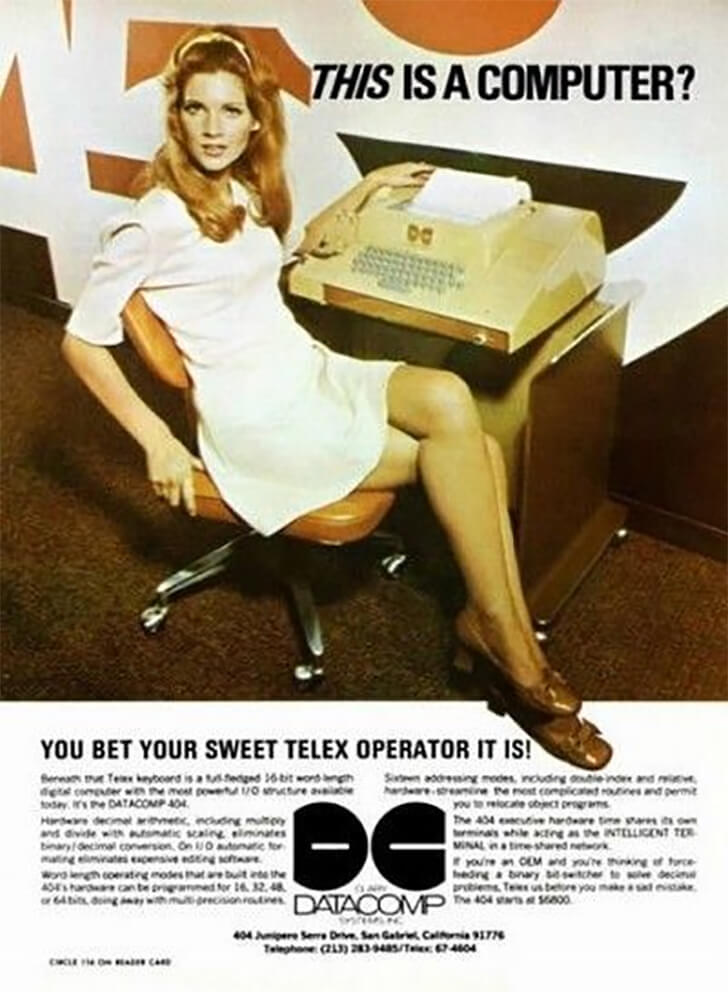
This ad subtly pokes fun at the stereotype that blondes are easily amazed, a cliché with roots in old Hollywood’s portrayal of blondes as the quintessential ‘damsels in distress,’ less savvy and more reliant on charm—an outdated concept that modern sensibilities have largely left behind.
Not All Women Can Cook!
A humorous old ad for Schlitz Beer taps into a relatable kitchen mishap—a burned meal. A tearful woman is consoled by her husband with a comforting truth: “At least the beers aren’t burned.” It’s a playful nod to culinary fails and the reassuring quality of a good beer.
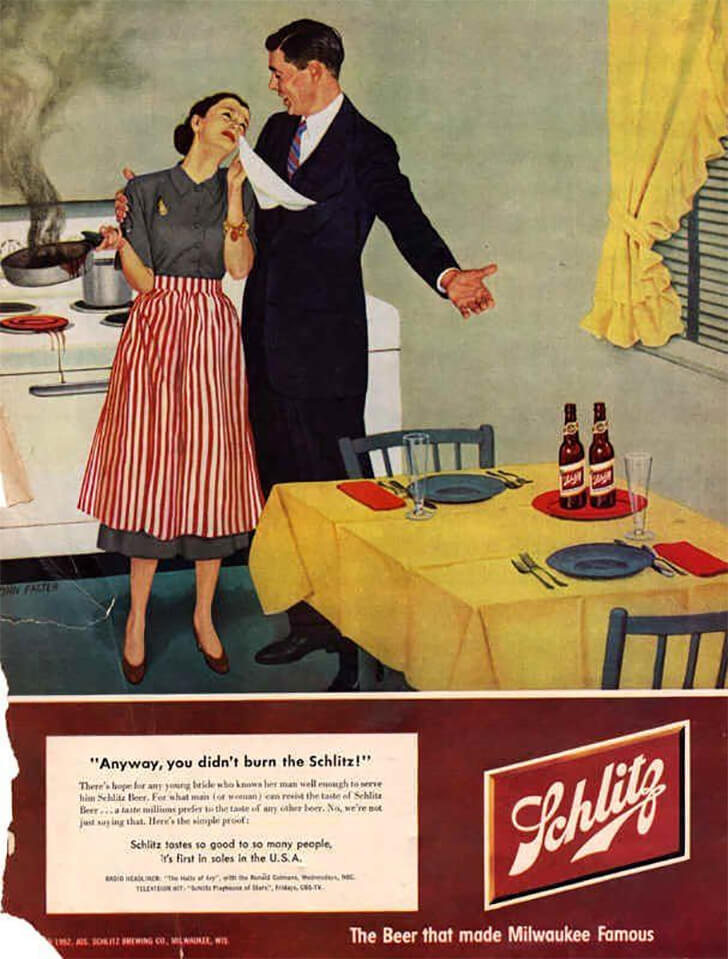
Its lighthearted take on domestic life is a subtle suggestion that, through thick and thin, a beer like Schlitz can uplift spirits. The brand should know that the nation that drinks this beverage the most is the Czech Republic.
No Wrinkles, Not One—People Wouldn’t Care
This Continental Oil marketing material would not mesh with today’s standards. Picture a man, hose in hand, dousing a woman with a carefree grin under the tagline “She doesn’t care.” The chuckle comes from the blatant cheekiness, a far cry from modern subtlety.
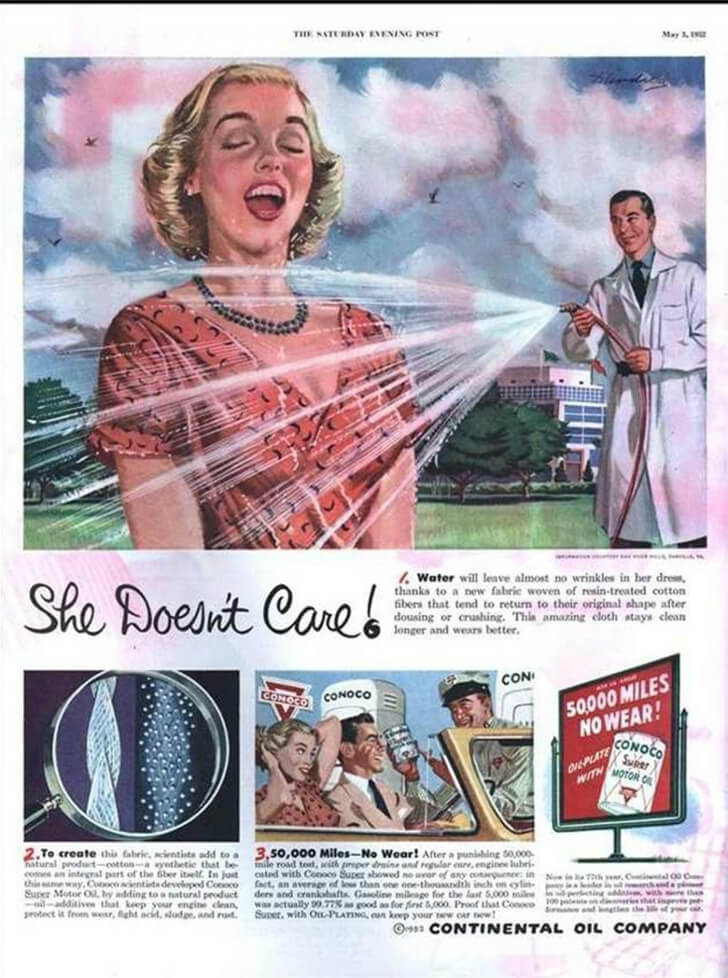
The ad comically plays on the unexpected, as we usually dread water near clothes. Speaking of attire, the breaking of hydrogen bonds in fibers during wear leads to those pesky wrinkles. This ad, while humorous, reminds us how many times ads have been pressed on, much like our clothes post-laundry.
In Yesteryear’s Standards…
The ad pitches the Ringlet undergarment as the secret to achieving a “10” in a time when society brazenly rated people’s looks on a scale. This suggests that Lovable’s product can transform one’s figure into party-season perfection.

The humor emerges from the ad’s straightforward equation of self-worth with chest size, reflecting a dated perspective that now seems almost satirical. It’s an artifact from when societal norms overtly endorsed such ratings, contrasting starkly with today’s celebration of diverse body types and a broader understanding of beauty.
Lucky Tiger, Lucky Guy
Lucky Tiger Hair Tonic’s ads were as wild as a safari hunt. The visual? A suave hunter surrounded by trophies, not of beasts, but of women’s portraits. This ad tickles the funny bone with its outdated and exaggerated claim that a well-groomed mane is the ultimate lasso for attention.
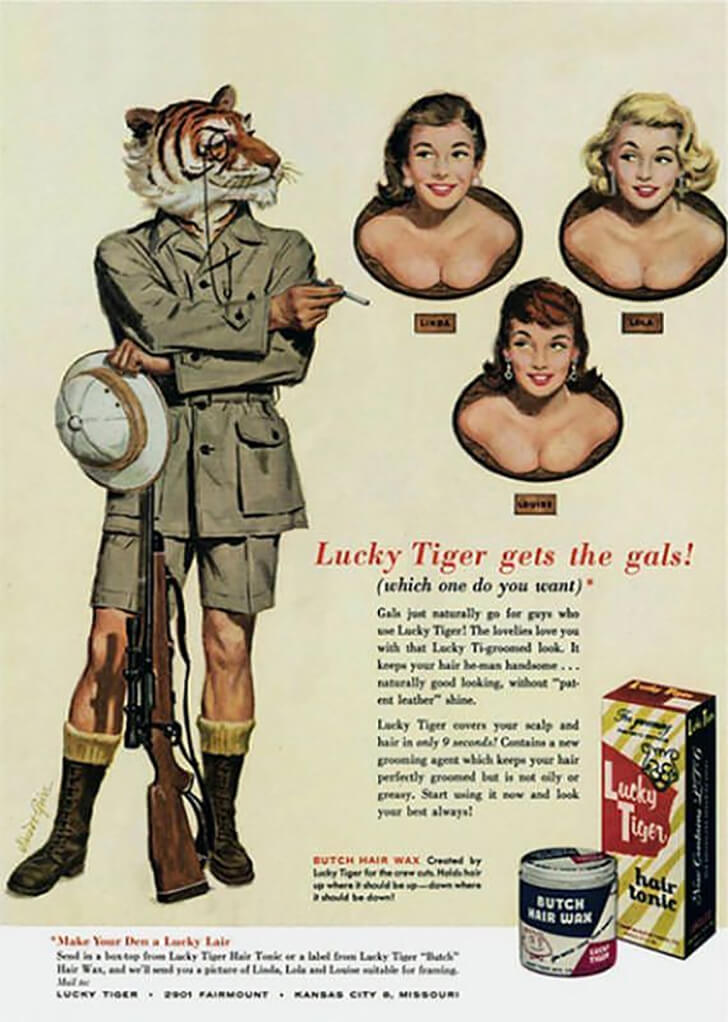
Hair tonics, like the one advertised, were the go-to for men seeking that ‘naturally good-looking’ style without the grease. They often contained alcohol, which cleansed the scalp, and oils for a smooth finish.
Kissable Lips Care Of This Lipstick
Featuring a woman poised above the product, the ad introduces “BRIGHT ‘N CLEAR,” Tanger’s then-newest lipstick shade in a dazzling red. It shows the audacious claims of being the “exact” shade recommended by beauty authorities and the “exciting miracle” of indelible, long-lasting color.
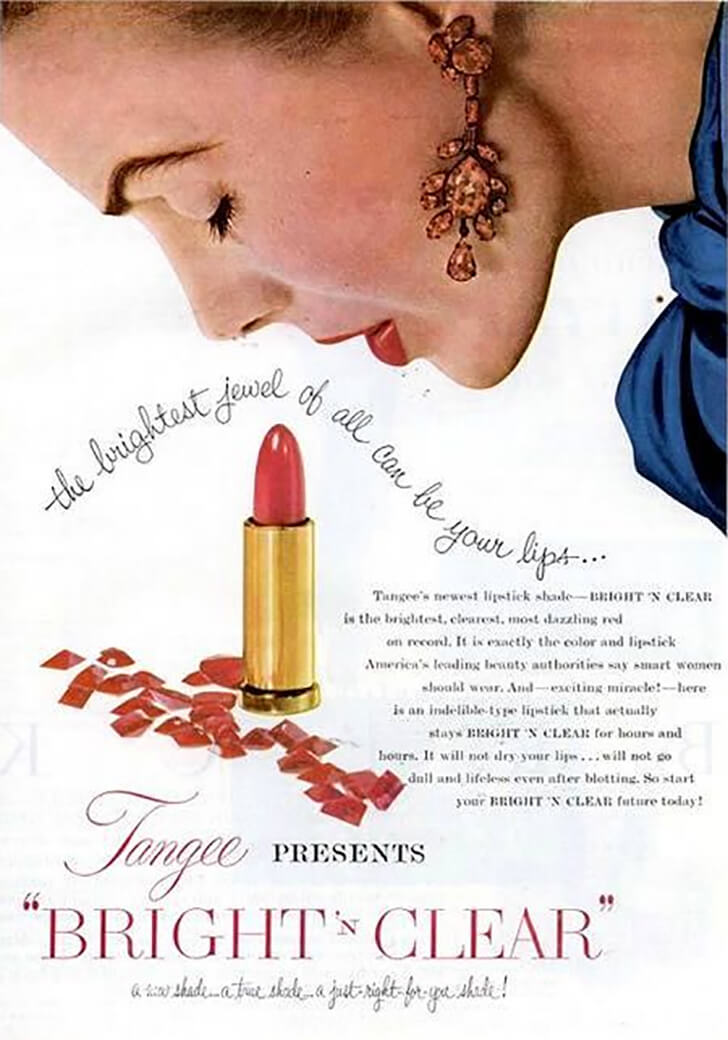
Red lipstick, like the hue in the ad, traces its origins to ancient civilizations. The Sumerians in 3500 BC used crushed red rocks, while Egyptian elites crafted vibrant red waxes with crushed insects, adorning the lips of iconic figures like Cleopatra.
Quite A Roomy Ride
In an era when legroom was the luxury du jour, the Pontiac Star Chief ad entices with a playful but cheeky twist. This whimsical phrasing tickles the funny bone, as it conjures images of sprawling with ease in a spacious interior.

Pontiac’s journey mirrors this ad’s spirit of resurgence; born from General Motors in 1926 and named for a famed Native American chief, it merged with Chevrolet during the tough 1930s. Triumphantly, Pontiac re-emerged, carving out its niche as the middle-class American’s chariot.
Useful Girls Because…
With the rallying cry, “The soldiers need our help! Gather ’round, American Women!” It initially seems to appeal to women’s patriotic duty. However, the twist comes with a problematic line about women being useful or not.
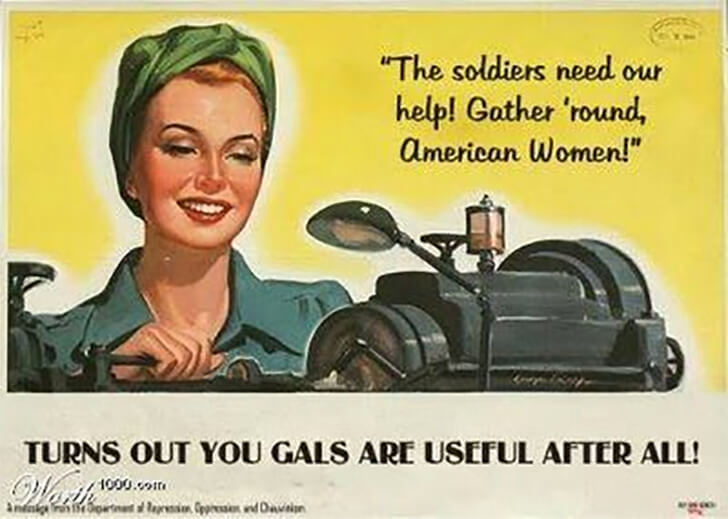
This highlights the outdated notion that women’s worth was often underestimated, only to be recognized in times of crisis. The ad provides a curious glimpse into historical attitudes toward women, emphasizing the importance of acknowledging and debunking such stereotypes. It’s a reminder of how far society has progressed in recognizing the invaluable contributions of women beyond wartime support.
No More Morning Breath to Keep Husbands In Their Places
The ad declares a half-warning, half-advice to wives about the virtues of fresh breath. Its intrigue comes from its unabashed use of fear of competition to promote oral hygiene. It’s a relic of times when ads were less subtle and more direct with their messaging.
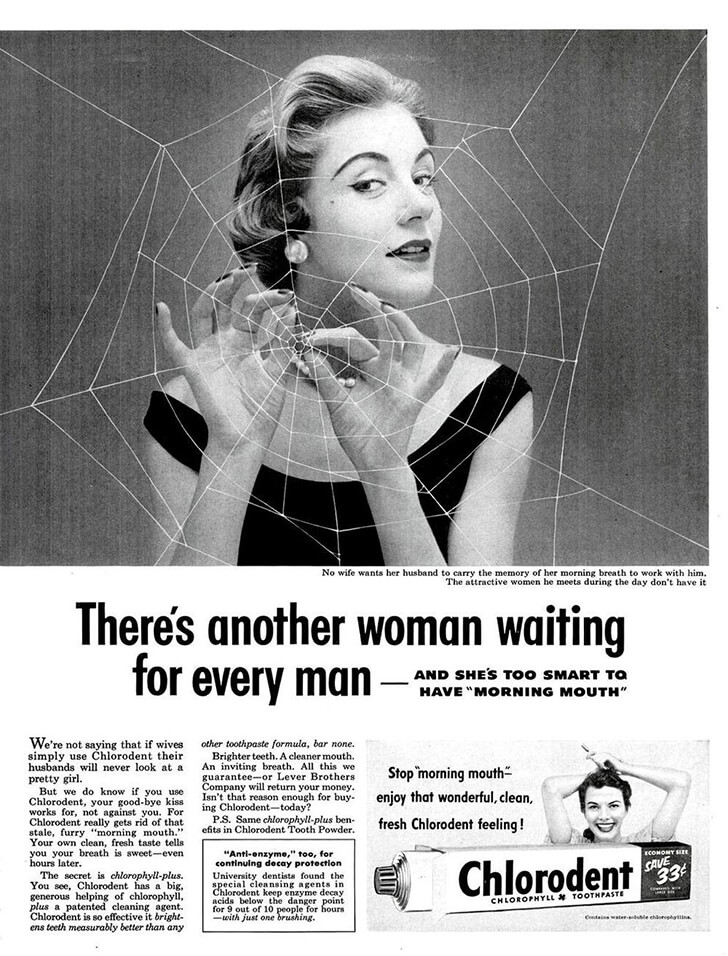
Morning breath, that unwelcome guest upon waking, results from a decrease in saliva during sleep, allowing bacteria to thrive, leading to that infamous “furry” feeling. Chlorodent’s solution? A “big, generous helping of chlorophyll,” playing chemist in the battle for minty-fresh kisses.
Who Needs Milk When There’s Cola?
This ad boldly claimed that starting infants on cola from the get-go promotes an active lifestyle, boosts personality, and provides essential sugars. It humorously suggests that introducing soda during early development ensures acceptance and popularity in the awkward pre-teen and teen years.

What makes it funny today is the outrageous notion that soda is a magic elixir for social success. In reality, cola is far from ideal for kids due to its high sugar content, which can lead to obesity, dental issues, and unhealthy habits.
Phosferine—Sip Away the Gloom Blues!
Phosferine Tonic Wine’s ad is a vintage vignette of optimism in a bottle. Who would have thought that fatigue or a hangover met their match in this “vitalizing drink?” Touting the power to banish the blues and elevate spirits, it’s a charming peek into past remedies.

The endorsement from Miss A. K. of Hereford adds a personal touch, making the tonic seem like a friend’s recommendation. This was the era of “nerve tonics,” a catch-all cure in the eyes of hopeful consumers, long before modern regulations would require a peek behind the curtain of such enthusiastic claims.
Listerine’s Matrimonial Magic
The 1934 Listerine ad is a hilarious time capsule, targeting the five million women eager for marital bliss. It humorously hyperbolizes halitosis as a make-or-break factor in love’s pursuit, suggesting that bad breath could be a charm’s undoing. The ad’s earnest tone—warning of the social perils of halitosis, unknowable to the afflicted—is amusingly dramatic and, at the same time, exaggerated.
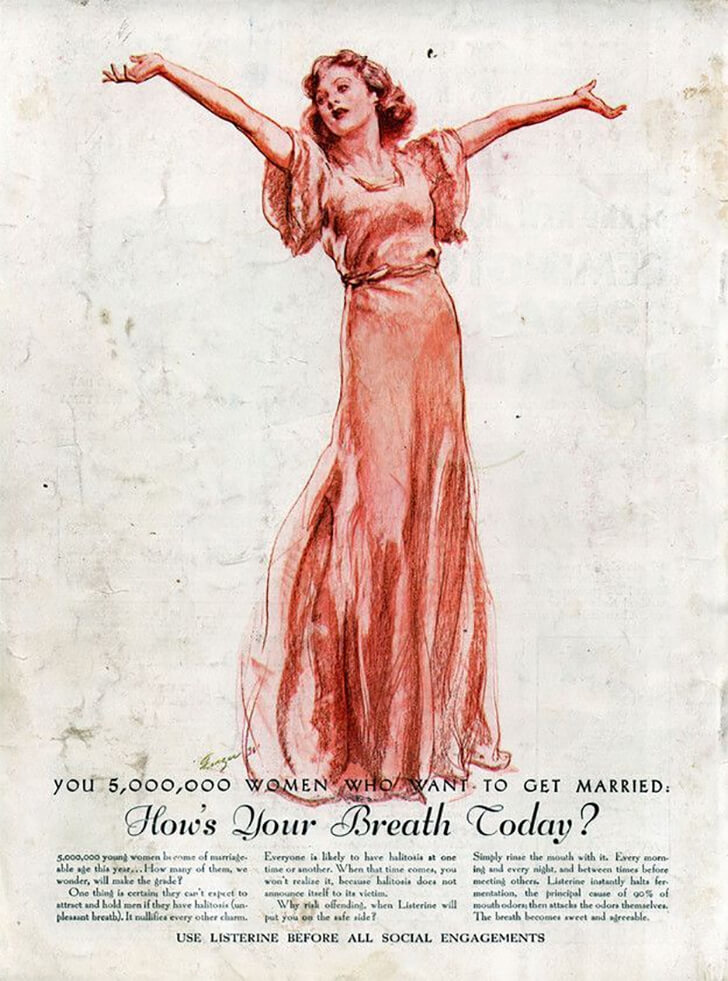
Listerine, named after antiseptic pioneer Joseph Lister, becomes the knight in shining armor, promising a sweet, agreeable breath for every social encounter. It’s a cheeky reminder of the quaint courtship concerns of yesteryears.
Coloring Hidden Dangers
Step into the whimsical world of 1923 with “The Dutch Boy’s Lead Party,” a paint book inviting children to a fantastical gathering. The cover teases the imagination, featuring Dutch Boy, paint bucket in hand, welcomed by an animated assembly: a toy soldier, a shoe, a plate, and a light bulb.

Inside, the Dutch Boy chats with the soldier, leading to a colorful adventure through 14 images, showcasing everyday items that contained lead unbeknownst to many at the time. These colorful scenes masked the serious undertones of lead’s hidden hazards.
Lysol Love Life Lifesaver or Ruse?
In the 1930s, a Lysol ad intriguingly navigates the stormy seas of feminine hygiene with a metaphor of maritime mishap: “Another Love-match Shipwrecked…” It cleverly disguises its message, suggesting Lysol as a lifesaver. Behind the euphemisms lies a hidden agenda; it was the clandestine companion in birth control, a role not openly discussed but widely understood.
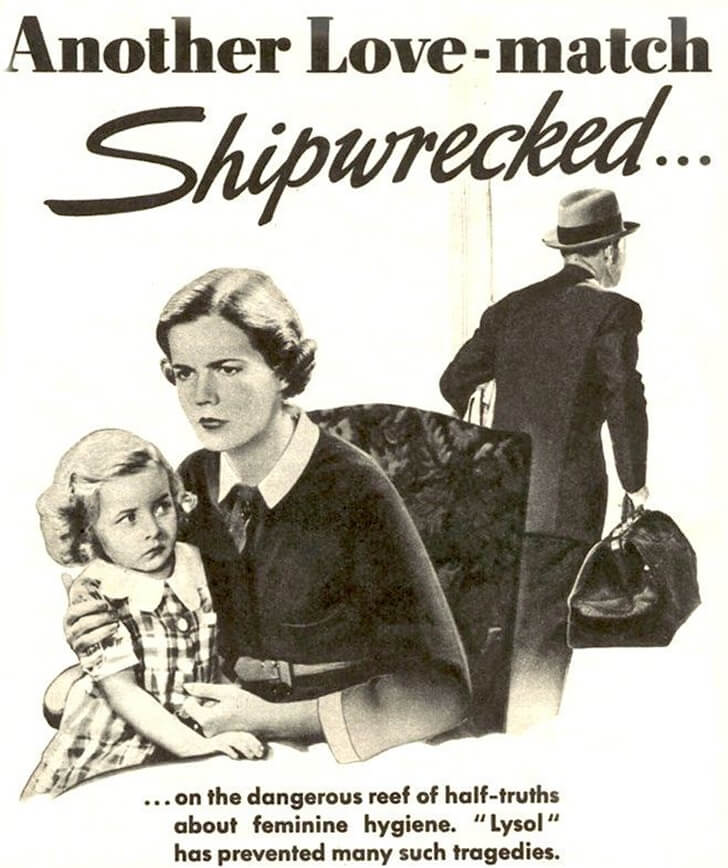
Phrases like “combatting germs” winked at much more than cleanliness, offering women discreet control over their lives in an era when even whispers of contraception were taboo.
Old Gold’s Leggy Coronation
The 1940s Old Gold cigarette ad presents a royal scene, with a man crowning a kneeling cigarette pack adorned with a woman’s legs. It’s a cheeky and problematic nod to the “king-size” length, perhaps likening the elongated elegance of the cigarettes to a lady’s limbs.
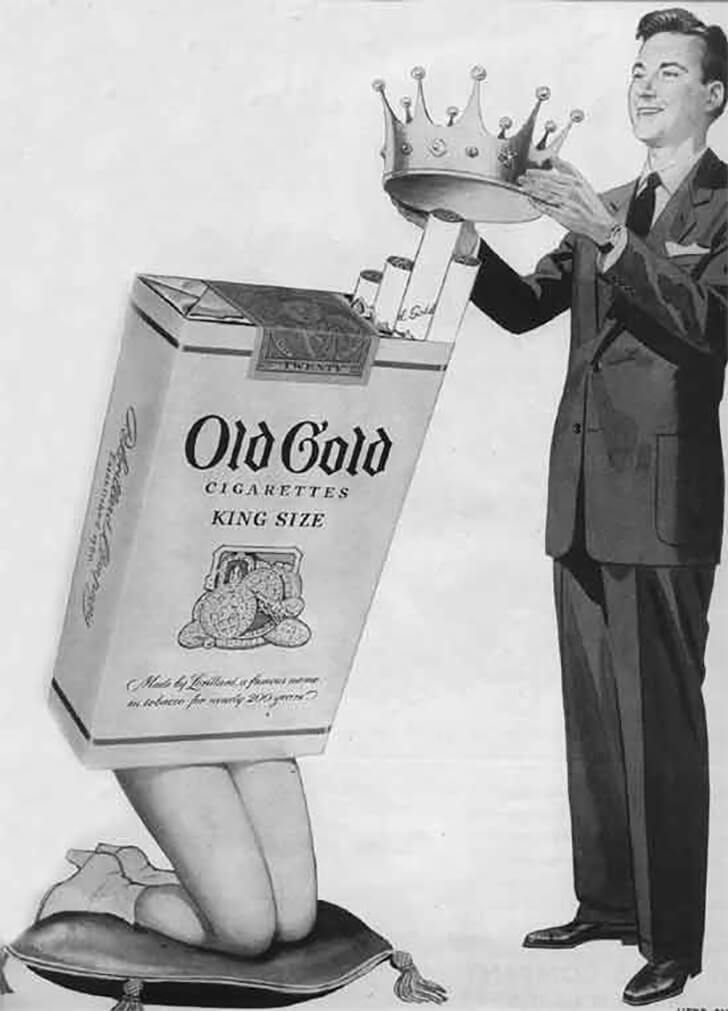
Since its 1926 debut by Lorillard Tobacco Company, Old Gold has been a market charmer, especially after the “Not a cough in a carload” campaign. By the 1950s, the brand danced onto TV with animated packs. Yet, amidst this glamor, the brand faced FTC scrutiny for unsubstantiated health claims.
Jungle Jive in Van Heusen Threads
The Van Heusen ad pitches “going native” with jungle print sport shirts featuring a man in safari chic atop a raffia throne, carried by women in animal print dresses. What’s problematic? The ad’s concept, swinging on vines of cultural insensitivity, would be frowned upon today for its trivialization of cultural attire and the portrayal of women as bearers of the throne.

While intended to be humorous with its ‘jungle fever’ fashion, this contrast mirrors the evolution of Phillips-Van Heusen from pushcart beginnings to a fashion powerhouse.
Sweet Relief? Dr. Miles’ Tablet Temptations
The 1910s Dr. Miles’ Laxative Tablets ad shows a joyful girl with a laxative tablet disguised as a treat. “Children coax for them because they taste like candy,” it claims. But what made this ad off-key? Today, this ad would raise red flags for encouraging medication to be seen as candy, potentially leading to overuse or misuse by children.
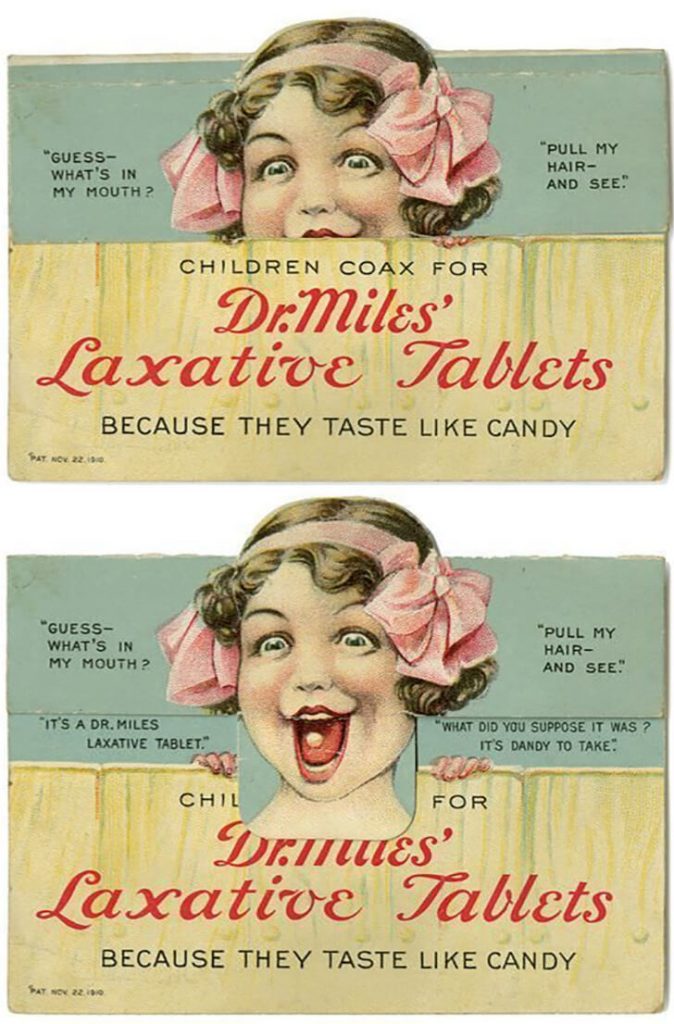
While the ad’s playful and creative nature might bring a smile, the serious implications of children confusing medicine with sweets are no laughing matter. In modern times, laxatives for kids are a doctor’s call, not a candy choice.
Navigating Through Stereotypes
This 1970s Mini Automatic advertisement stands out with its questionable portrayal of women in the automotive industry. Emblazoned with the slogan “The Mini automatic. For simple driving,” this ad shows a woman appearing bewildered behind the wheel, inadvertently steering into the stereotype that women prefer easier-to-drive, non-complicated vehicles.
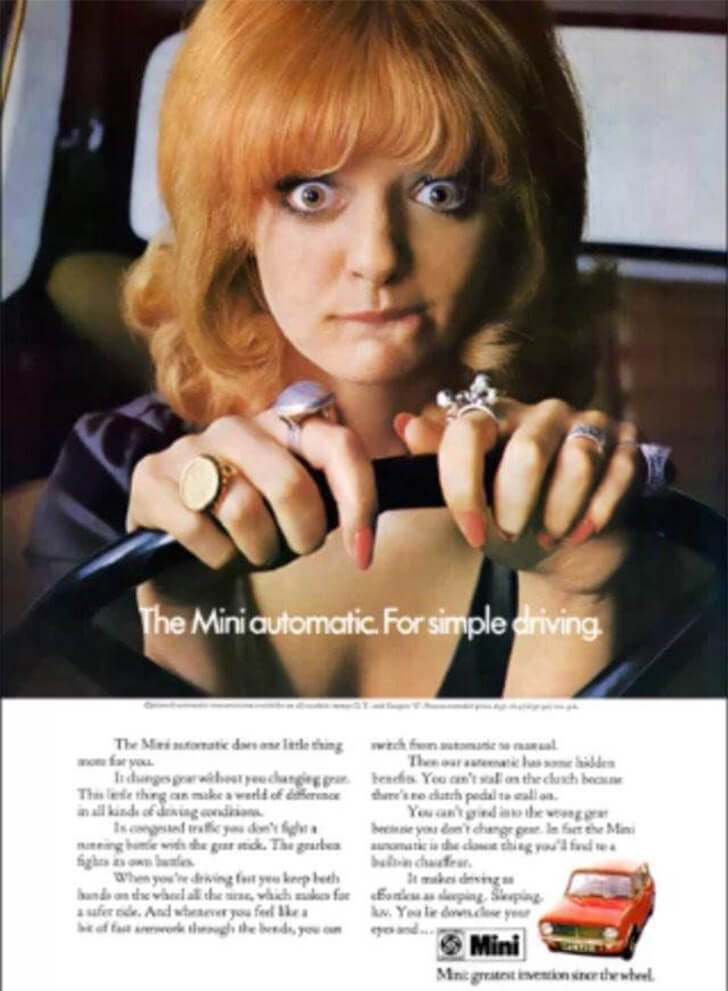
Ironically, the Mini, a symbol of innovative British automotive design, was entangled in an advertising approach that drove down a less enlightened road, in stark contrast to its trailblazing nature in car manufacturing.
Silva Thins’ Questionable Comparison
A 1960s Silva Thins ad had the backdrop of a slender woman’s silhouette, a cigarette pack, and a man sampling the product. Why the controversy? It’s a classic case of objectification, reducing women to mere comparisons with cigarettes—thin and wealthy as desirable traits.
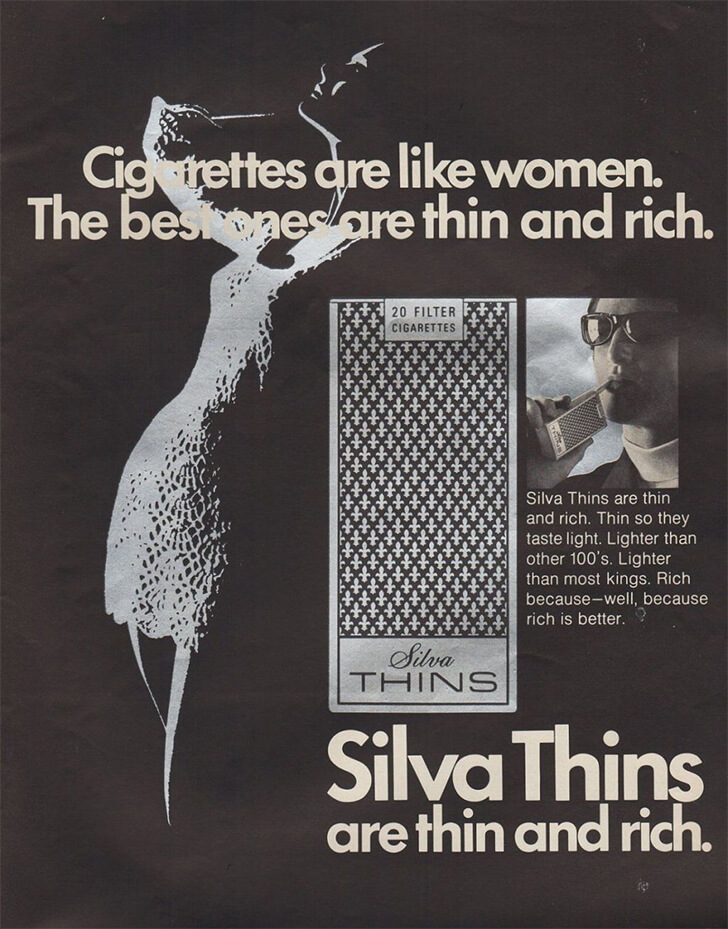
Far from humorous, it’s a blatant perpetuation of unrealistic beauty standards. Such ads sold cigarettes and a narrow, exclusive idea of beauty, sidelining the diversity and richness of real women’s experiences and appearances. It is safe to say that this wouldn’t be acceptable today.
Empowerment or Misguided Message?
Balls Candy swung into the scene with a bold slogan in the 1970s. Featuring a woman in a yellow shirt emblazoned with an audacious claim, the ad mixes empowerment with questionable taste. While it nods to trailblazers like Joan of Arc and Amelia Earhart, the slogan and the shirt wade into murky messaging waters.
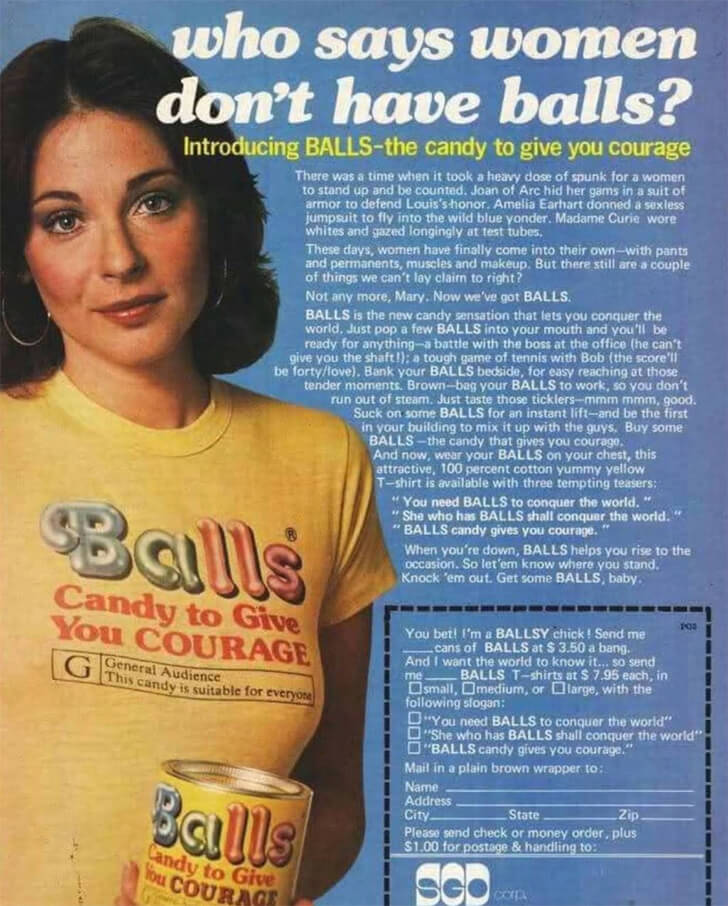
It’s a cheeky, if not cringeworthy, attempt to equate candy with courage, wrapped in a pun that undermines its own empowering intent. Balls Candy’s campaign is a sour bite in advertising history.
Palmolive’s Pitch—Beauty Over Brains?
In the roaring 1920s, a Palmolive soap ad sparked a conversation with its tagline: “Most men ask ‘Is she pretty?’ not ‘Is she clever?'” Featuring a woman in her boudoir, peering over her shoulder, the ad, crafted by artist Rolf Armstrong, subtly suggests beauty is more valued than intellect.
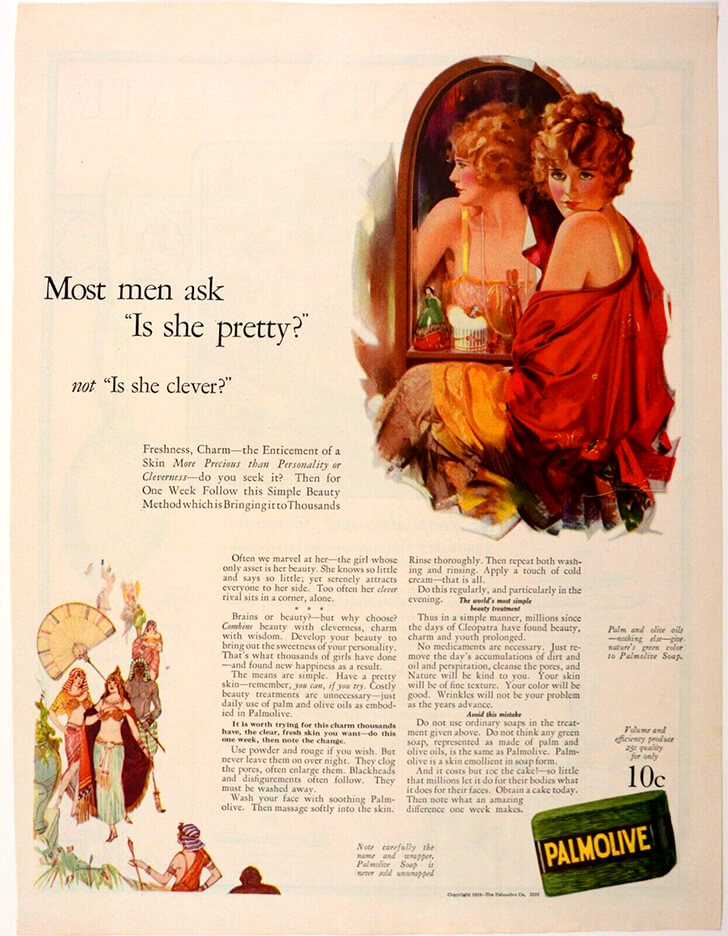
While clever in its appeal, today, this ad would be challenged for reinforcing dated views on women’s worth. Palmolive, renowned for its unique blend of oils and celebrated as a Pharaoh’s choice, made waves with its marketing at the time.
Betty Barclay’s Booth—Dialing Up Style
Imagine stepping into a 1960s phone booth and finding it’s a runway for Betty Barclay’s summer shirt-waist dresses. The ad features a woman clad in vibrant dresses, buzzing the phone booth.

While whimsical, the ad’s underlying message raises eyebrows today: it implies that the right dress can boost a woman’s popularity, a concept that skews the importance of appearance over substance. This portrayal reflects a dated view of women’s social value, subtly hinting that fashion is a key to social success.
The ‘Magic’ Mineral’s Murky Tale
In the 1930s, Johns Manville hailed asbestos as a “magic mineral” for farms, fireproof and indestructible. An ad, with hands cradling asbestos rock, touts its endurance against fire, weather, and wear. The irony? This ‘magic’ harbored a dark secret.
Asbestos, dating back to ancient Finland for pottery reinforcement, was a construction darling until its health horrors surfaced.
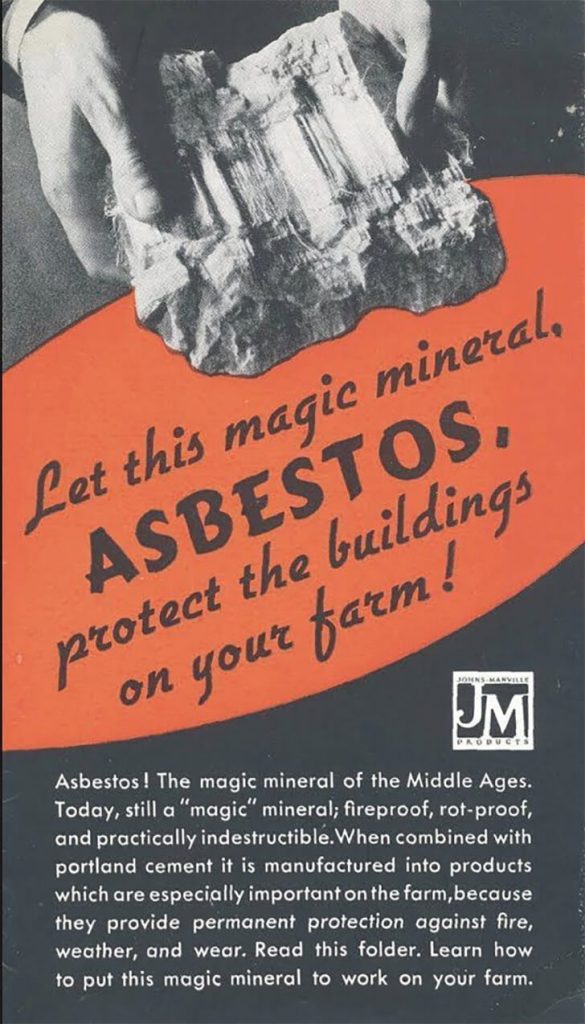
Once prized, it became notorious for causing asbestosis and mesothelioma, leading to extensive regulations. This ad echoes a time when its promises overshadowed the dangers of asbestos.
Mr. Leggs Slacks—Stepping Beyond Bounds
The Mr. Leggs slacks ad boldly states, in an audacious display of the old advertising norms, “It’s nice to have a girl around the house,” featuring a man stepping on a woman’s head, bizarrely part of a tiger rug. This visual showcases a jarring blend of humor and misogyny.
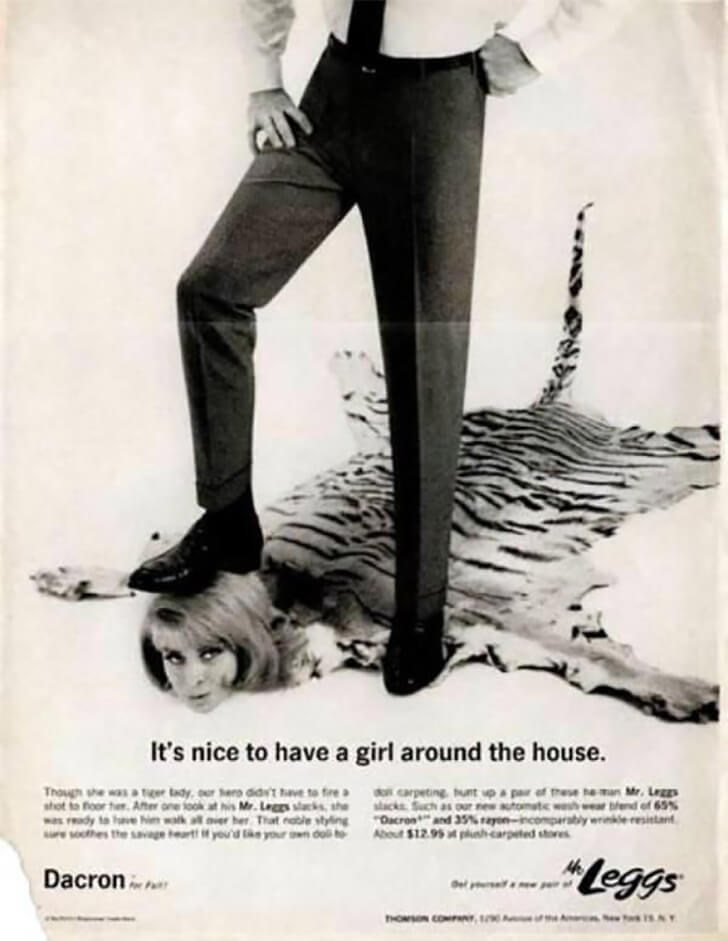
Far from amusing in today’s lens, it’s a stark portrayal of how ads once objectified women, trivializing their role to mere decorative pieces. A relic of its time, this ad mirrors the pressing need to evolve gender portrayal in media.
Brews and Misplaced Views
Humor hops alongside controversy in this old Guinness beer ad. Here is the twist—it features a red-headed woman atop a pint, blending allure with ale. While aiming for a chuckle, it stumbles into the murky and disappointing territory of objectification, using a woman’s image to sell beer. Why can’t they just stick to toucans?

This brew of humor and misogyny reflects a dated advertising approach, where alcohol’s allure is often mingled with gender stereotypes. A reminder that sometimes, a pint is best served with respect, not stereotypes.

You must be logged in to post a comment Login